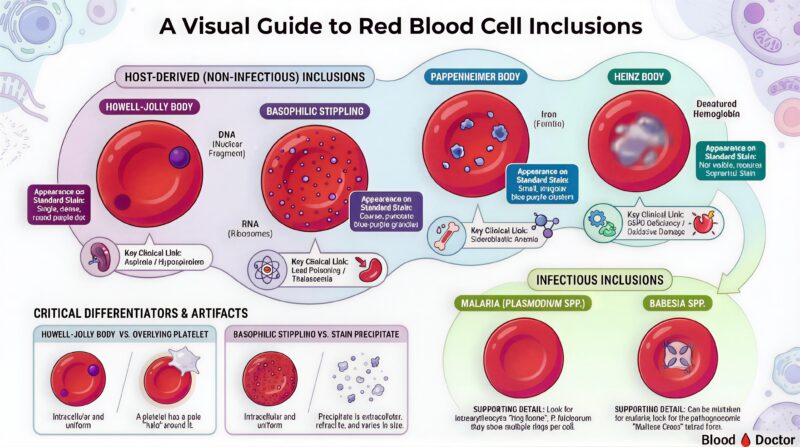
Abdul Mannan – The RBC Crime Scene: Decoding Inclusions on the Blood Film
Abdul Mannan, Consultant Haematologist at Betsi Cadwaladr University Health Board, posted on LinkedIn:
”The RBC “Crime Scene”: Decoding Inclusions on the Blood Film
As Haematologists, we are essentially detectives. When we look down the microscope, the Red Blood Cells often leave us clues about systemic pathology – we just need to know how to interpret them.
Morphology is the foundation of diagnosis.
Here is a visual breakdown of the classic RBC inclusions we encounter, and what they represent:
1. Howell-Jolly Bodies (The DNA Remnant)
• Composition: DNA (Nuclear fragment).
• The Clue: Usually indicates the spleen is absent (asplenia) or not functioning (hyposplenism). The spleen usually “bites” these out; without it, they persist.
2. Basophilic Stippling (The RNA Scatter)
• Composition: Precipitated RNA (Ribosomes).
• The Clue: Think distinct toxic insults like Lead Poisoning, or hemoglobin synthesis issues like Thalassemia.
• Pearl: Don’t confuse this with stain precipitate!
3. Pappenheimer Bodies (The Iron Clumps)
• Composition: Iron (Ferritin).
• The Clue: Seen in Sideroblastic Anemia or post-splenectomy.
• Pearl: These tend to cluster, unlike the diffuse scatter of basophilic stippling.
4. Heinz Bodies (The Ghost)
• Composition: Denatured Hemoglobin.
• The Clue: G6PD Deficiency or oxidative damage.
• Pearl: You won’t see these clearly on a standard Wright/Giemsa stain! You need a Supravital Stain to visualize them.
5. The Invaders (Infectious)
• Malaria: Look for the classic ring forms.
• Babesia: Look for the pathognomonic “Maltese Cross” tetrad form.
The Traps (Artifacts)
Always verify before you diagnose. A platelet sitting on top of an RBC can look exactly like a Howell-Jolly body (look for the halo).
Which of these inclusions do you find post-graduates struggle to identify the most?”

Keep up with Hemostasis Today.
-
Nov 27, 2025, 16:00Nathan Connell on WFH AI Summaries from the Global Forum
-
Nov 27, 2025, 15:49Piotr Czempik: Rethinking Coagulation in Acute Liver Dysfunction
-
Nov 27, 2025, 15:35Overwhelmed? A Leader’s Guide from Mark Crowther to Getting Back on Track
-
Nov 27, 2025, 15:10Wolfgang Miesbach’s Top 10 Picks for TTP and Thrombosis from ASH 2025
-
Nov 27, 2025, 14:24ICCBBA’s Executive Director Eoin McGrath Chairs a Dynamic Session on AI, Innovation and Informatics in Transfusion Medicine
-
Nov 27, 2025, 13:26Wolfgang Miesbach’s Top 10 Picks for Bleeding Disorders from ASH 2025
-
Nov 27, 2025, 11:19Priya Prasad Presents a Case of Severe Hypotensive Transfusion Reaction
-
Nov 27, 2025, 04:07Eugene Tang Presents Highlights from UK Stroke Forum 2025
-
Nov 27, 2025, 03:47Michael Makris: I Believe the Time Has Come to Consider Emicizumab Up Front in Persons with Acquired Hemophilia
